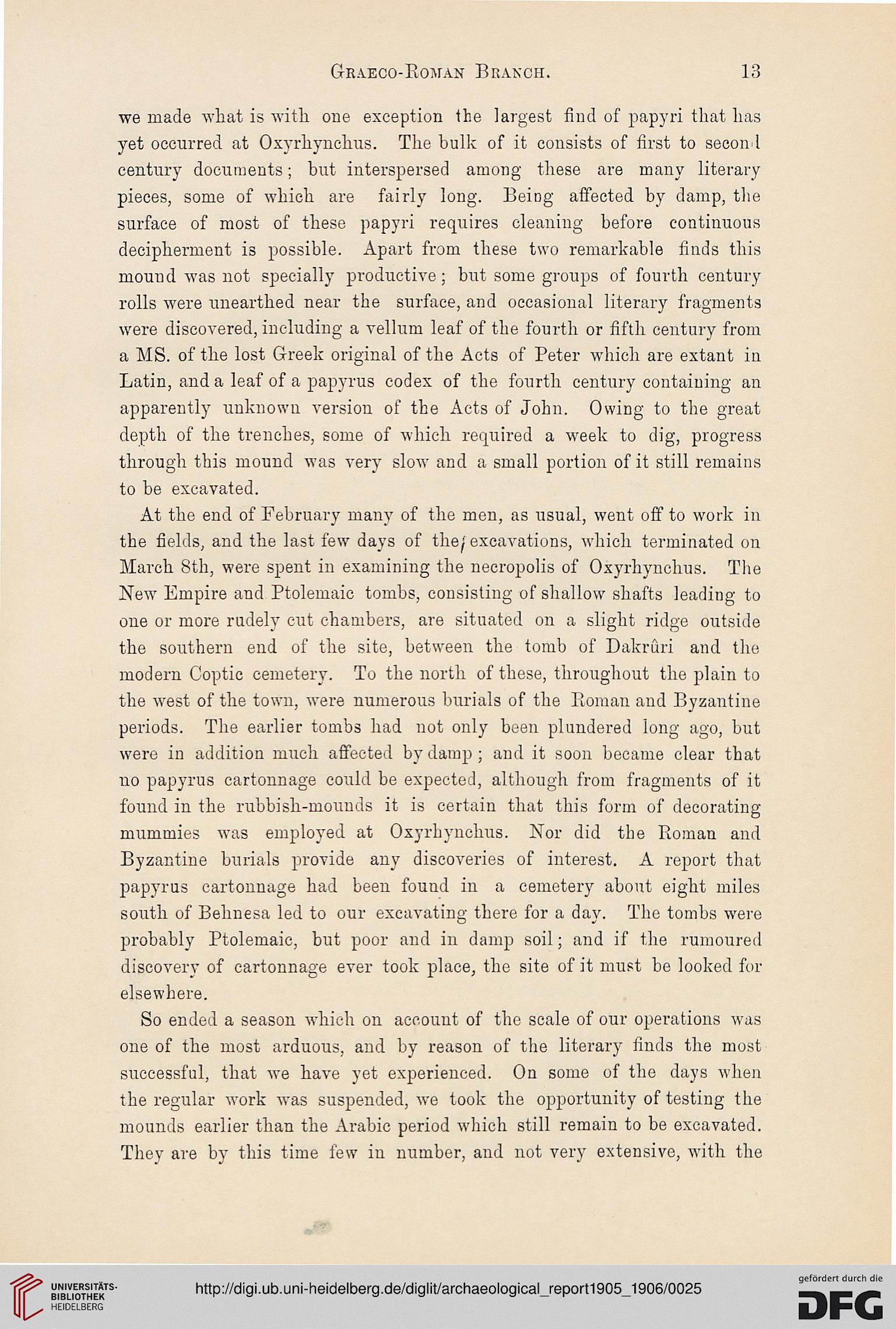Gbaeco-Roman Branch.
13
we made what is with one exception the largest find of papyri that has
yet occurred at Oxyrhynchus. The bulk of it consists of first to second
century documents; but interspersed among these are many literary
pieces, some of which are fairly long. Being affected by damp, the
surface of most of these papyri requires cleaning before continuous
decipherment is possible. Apart from these two remarkable finds this
mound was not specially productive; but some groups of fourth century
rolls were unearthed near the surface, and occasional literary fragments
were discovered, including a vellum leaf of the fourth or fifth century from
a MS. of the lost Greek original of the Acts of Peter which are extant in
Latin, and a leaf of a papyrus codex of the fourth century containing an
apparently unknown version of the Acts of John. Owing to the great
depth of the trenches, some of which required a week to dig, progress
through this mound was very slow and a small portion of it still remains
to be excavated.
At the end of February many of the men, as usual, went off to work in
the fields, and the last few days of the^'excavations, which terminated on
March 8th, were spent in examining the necropolis of Oxyrhynchus. The
New Empire and Ptolemaic tombs, consisting of shallow shafts leading to
one or more rudely cut chambers, are situated on a slight ridge outside
the southern end of the site, between the tomb of Dakruri and the
modern Coptic cemetery. To the north of these, throughout the plain to
the west of the town, were numerous burials of the Roman and Byzantine
periods. The earlier tombs had not only been plundered long ago, but
were in addition much affected by damp; and it soon became clear that
no papyrus cartonnage could be expected, although from fragments of it
found in the rubbish-mounds it is certain that this form of decorating
mummies was employed at Oxyrhynchus. Nor did the Roman and
Byzantine burials provide any discoveries of interest. A report that
papyrus cartonnage had been found in a cemetery about eight miles
south of Behnesa led to our excavating there for a dav. The tombs were
probably Ptolemaic, but poor and in damp soil; and if the rumoured
discovery of cartonnage ever took place, the site of it must be looked for
elsewhere.
So ended a season which on account of the scale of our operations was
one of the most arduous, and by reason of the literary finds the most
successful, that we have yet experienced. On some of the days when
the regular work was suspended, we took the opportunity of testing the
mounds earlier than the Arabic period which still remain to be excavated.
They are by this time few in number, and not very extensive, with the
13
we made what is with one exception the largest find of papyri that has
yet occurred at Oxyrhynchus. The bulk of it consists of first to second
century documents; but interspersed among these are many literary
pieces, some of which are fairly long. Being affected by damp, the
surface of most of these papyri requires cleaning before continuous
decipherment is possible. Apart from these two remarkable finds this
mound was not specially productive; but some groups of fourth century
rolls were unearthed near the surface, and occasional literary fragments
were discovered, including a vellum leaf of the fourth or fifth century from
a MS. of the lost Greek original of the Acts of Peter which are extant in
Latin, and a leaf of a papyrus codex of the fourth century containing an
apparently unknown version of the Acts of John. Owing to the great
depth of the trenches, some of which required a week to dig, progress
through this mound was very slow and a small portion of it still remains
to be excavated.
At the end of February many of the men, as usual, went off to work in
the fields, and the last few days of the^'excavations, which terminated on
March 8th, were spent in examining the necropolis of Oxyrhynchus. The
New Empire and Ptolemaic tombs, consisting of shallow shafts leading to
one or more rudely cut chambers, are situated on a slight ridge outside
the southern end of the site, between the tomb of Dakruri and the
modern Coptic cemetery. To the north of these, throughout the plain to
the west of the town, were numerous burials of the Roman and Byzantine
periods. The earlier tombs had not only been plundered long ago, but
were in addition much affected by damp; and it soon became clear that
no papyrus cartonnage could be expected, although from fragments of it
found in the rubbish-mounds it is certain that this form of decorating
mummies was employed at Oxyrhynchus. Nor did the Roman and
Byzantine burials provide any discoveries of interest. A report that
papyrus cartonnage had been found in a cemetery about eight miles
south of Behnesa led to our excavating there for a dav. The tombs were
probably Ptolemaic, but poor and in damp soil; and if the rumoured
discovery of cartonnage ever took place, the site of it must be looked for
elsewhere.
So ended a season which on account of the scale of our operations was
one of the most arduous, and by reason of the literary finds the most
successful, that we have yet experienced. On some of the days when
the regular work was suspended, we took the opportunity of testing the
mounds earlier than the Arabic period which still remain to be excavated.
They are by this time few in number, and not very extensive, with the





